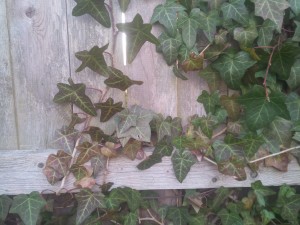The experts agree; Napoleon never uttered that famous palindrome, “Able was I ere I saw Elba”. It isn’t a palindrome in French, and even in exile, Napoleon probably never admitted that a comeback wasn’t waiting somewhere in the wings. Since any claim to Napoleonic authorship has now been discredited, I will feel free to alter the palindrome and assert my own truth, “Able was I ere I saw ivy.”
There is no doubt that English ivy or Hedera helix is beautiful, with its glossy leaves, vigorous habit and ability to cloak even the ugliest structure in a cascade of green. Once established it needs absolutely nothing from the gardener and will survive all kinds of horticultural and ecological insults. As if that wasn’t enough, English ivy comes in a wide array of forms, from compact, small-leafed varieties, like ‘Anita’, to variegated charmers, including the fetchingly splotched ‘Golden Ingot’.
So what is the problem?
Very simply put, English ivy is unstoppable. My garden right now is covered in the last of the snow from the last of this year’s nor’easters. I can barely see the most brazen leaves in the various ivy patches, but I know what is going on. Even covered by a wintery blanket, with their roots imprisoned in cement-like soil, the ivy is plotting garden domination.
The ivy on my property pre-dates my ownership. It went in sometime after the house was built in 1882, unless, of course, it simply migrated before that from an even older property. Ivy is like that. I have seen it romping through untended cemeteries, clambering up the surviving brickwork of abandoned factories and scaling the heights of lofty evergreens.
English ivy first arrived in North America with European settlers. While the settlers did battle with disease, starvation and bad weather, ivy blithely escaped Colonial gardens and spread by all available means. With few natural predators, it glided over multiple acres, climbed by aerial rootlets, produced abundant seed and rooted wherever its stems touched the ground. Its success made it the robber baron of cultivated plants. Now, over three centuries after the first cuttings rooted in America, English ivy is considered invasive in the eastern third of the United States and parts of the west coast.
My ivy issues stem—literally and figuratively—from two circumstances. My focus on plants other than ivy has allowed the pernicious vine to spread over the years. I have also aided its proliferation by transplanting perennials that grew near the original patches. Despite my heroic efforts to eliminate any ivy roots from the soil around the transplants, the ivy outsmarted me.
Fortunately, with the renewed vigor that all gardeners feel in spring, I am ready to tackle the ivy infestation in my garden. Herbicides are a non-starter for me and I try to avoid them whenever possible. Besides, the ivy that I don’t want grows cheek by jowl with the perennials that I like. Blasting the ivy with herbicides would endanger those desirable plants.
If I am feeling strong and want to get physical, I can simply start yanking the ivy out. This is a very cathartic and satisfying exercise, especially if you use it to channel lingering hostility towards any particular person, situation or event. If your unwanted ivy patch is small, or you can take on a larger infestation in increments, yanking may be your ticket. One caveat–if you choose the incremental route, make sure you don’t wait too long between increments. Ivy is notorious for its ability to make up for lost time and lost ground.
If you feel Agatha Christie-ish, you can also murder your ivy by smothering. Landscape fabric laid over the patch and camouflaged with a good layer of organic mulch works well for this. If you are thrifty and still subscribe to newspapers, substitute a thick layer of newsprint for the landscape fabric. In either case, watch the edges of the covered area for fugitive ivy that is yearning to break free and rampage once again. Yank it out when you see it.
Human nature is fickle and it is entirely possible to love certain Hedera helix cultivars for their elegant appearance and hate the species form that threatens the expensive hellebores. If you experience that duality, keep the existential crisis at bay by selecting one of the more civilized ivy varieties from the spring array at local nurseries and garden centers. The small-leafed, lightly variegated ‘Glacier’ is a good example. Plant it in containers either indoors or outdoors. When it gets too leggy, trim it back. The urge to commit hedera-cide will never enter your mind and you can go about your spring garden chores with a clear conscience.

